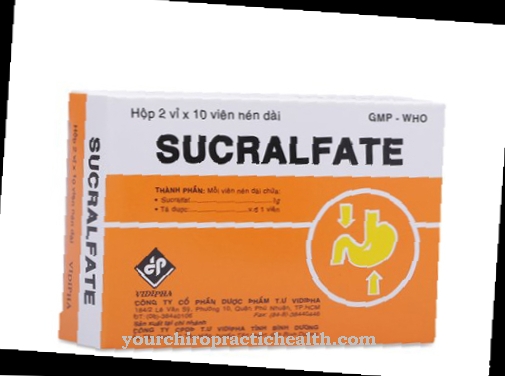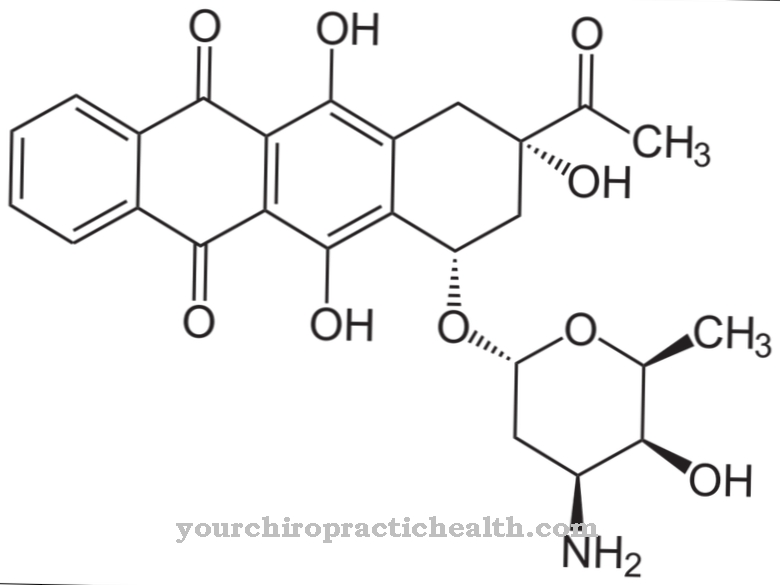Ajmaline is extracted from the roots of Rauwolfia serpentina, the Indian snake root. It requires a prescription and is used to treat irregular heartbeat. In Germany it is available under the trade name Gilurytmal®.
What is ajmaline?

Ajmaline is an indole alkaloid. The active ingredient of the Indian snake root is prescribed in the prescription drug Gilurytmal® of the class I antiarrhythmics for cardiac arrhythmias in the form of supraventricular tachycardias.
These arrhythmias to be treated with ajmaline must be accompanied by an increased pulse rate and originate in the atria. These arrhythmias include, for example, palpitations emanating from the AV node, palpitations in WPW syndrome or paroxysmal atrial fibrillation.
Ajmaline is also used in emergency medicine for the acute therapy of symptomatic supraventricular tachycardias that require treatment and for life-threatening ventricular tachycardias.
The active ingredient ajmaline is available as a 50 mg / 10 ml injection solution and is always injected intravenously. Later, 90% of the active ingredient is excreted via the liver and 10% via the kidneys.
Pharmacological effect
Ajmaline acts as a sodium channel antagonist. It delays the influx of sodium ions into the heart muscle cells. Muscle cells need sodium ions in order to be able to contract. This reduces the spread of excitation in the rapidly conducting areas of the heart.
The duration of the action potential in the atria and ventricles is thus extended. As a result, the functional refractory period is also extended, which in turn leads to an increased stimulus threshold. Overall, this results in a slower heartbeat and a reduction in the beating power of the heart. The effect on the general cardiovascular system is rather small. Nevertheless, careful attention should be paid to possible negative inotropia and bradycardia tendency.
The pharmacological effect lasts up to 2 minutes and lasts around 20 minutes. So it is easy to steer. It is recommended that you inject ajmaline very slowly to avoid accidental overdose. 5 minutes is a good time to inject. If the heart is already damaged, it should be a few more minutes.
Medical application & use
Ajmaline is used to treat cardiac arrhythmias that originate in the auricles and are accompanied by an accelerated pulse rate. Supraventricular tachyarrhythmias such as AV-junctional tachycardias, supraventricular tachycardias in WPW syndrome or paroxysmal atrial fibrillation, which are symptomatic and in need of therapy, are among the classic areas of application of ajmaline.
There are also life-threatening ventricular tachycardias. Ajmaline can also be used excellently in emergency medicine.
The effect sought with the administration of ajmaline can be assessed in two points:
- Slow heartbeat
- Attenuation of the conduction of excitation in the heart
Ajmaline, a class I antiarrhythmic drug, should not be combined with other antiarrhythmic drugs in this class. Otherwise there is a risk of serious side effects. A combination with drugs such as beta blockers or calcium channel blockers also increases the effect on the AV conduction of the cardiac conduction system and reduces its pumping capacity.
Especially when ajmaline is administered by continuous drip infusion, it should be taken into account that it increases the effect of drugs such as beta blockers, antidepressants and neuroleptics, as it hinders their breakdown in the organism.
Therapy with ajmaline is excluded in:
- Ajmaline hypersensitivity
- AV block II. And III. Degree
- pre-existing conduction disorders in the ventricles
- existing cardiac muscle weakness, because ajmaline would aggravate it. A significant increase in the spread of excitation within the ventricles or if the entire electrical ventricular function is prolonged, as this could be additionally delayed
- Adam Stokes Seizures
- Myasthenia gravis
- Intoxication with cardiac glycosides
- Bradycardia
- abnormal heart muscle enlargement
- within the first 3 months after myocardial infarction
- Left ventricular failure with less than 35% of normal output
You can find your medication here
➔ Medicines for cardiac arrhythmiasRisks & side effects
A dreaded side effect of ajmaline is paradoxically proarrhythmic reactions of the heart. They can mainly occur in people with CHD. Seizures occur rarely and blood count changes are even less common.
In addition to the exclusion criteria listed for medical use, ajmaline is still not to be used in cases of pronounced hypotension and severe electrolyte disturbances. Exceptions can be made for SA blocks, higher degree AV blocks, sinus node syndrome, and severe bradycardia if the patient has a pacemaker.
Since ajmaline is excreted via the liver and kidneys, the dosage should be adjusted if the liver or kidney function is impaired.
























.jpg)



